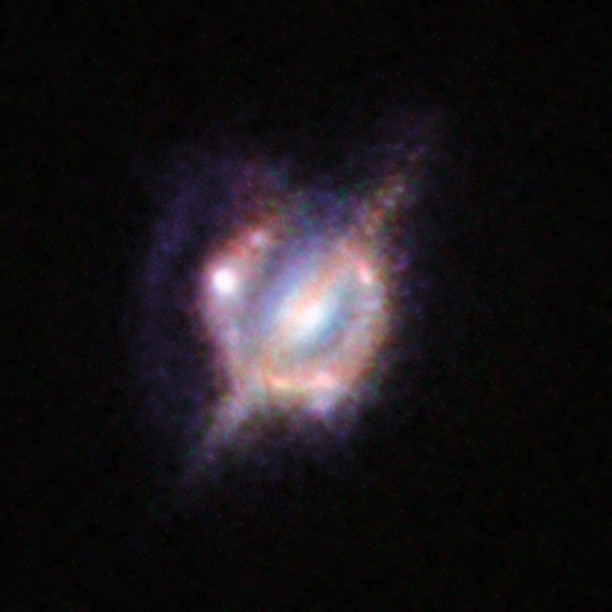Merging galaxies in the distant Universe through a gravitational magnifying glass
-
 by
c_cld
by
c_cld
The galaxyzoo logo published by ESO 😃
 H-ATLAS J142935.3-002836
H-ATLAS J142935.3-002836Credit:
ESO/NASA/ESA/W. M. Keck Observatory
In this picture you can see the foreground galaxy that is doing the
lensing, which resembles how our home galaxy, the Milky Way, would
appear if seen edge-on. But around this galaxy there is an almost
complete ring — the smeared out image of a star-forming galaxy merger
far beyond.Colours & filters Band Telescope
blue Infrared f110w Hubble Space Telescope WFC3
green Infrared H Keck
red Infrared K Keck
Posted
-
 by
c_cld
by
c_cld
H-ATLAS J142935.3-002836 in SDSS:
1237648720710206422
SDSS J142935.23-002835.6 -- sub-millimetric source / z(spectroscopic) 1.026
Posted
-
 by
ElisabethB
moderator
by
ElisabethB
moderator
Oh wow ! Just amazing ! 😄
Posted
-
 by
c_cld
by
c_cld
arXiv:1406.4859 Hugo Messias, Simon Dye, Neil Nagar, et all
Herschel-ATLAS and ALMA: HATLAS J142935.3-002836, a lensed major merger at redshift 1.027
(Submitted on 18 Jun 2014)
[Abridged]
Aims: This work focuses on one lensed system, HATLAS J142935.3-002836 (H1429-0028), selected in the Herschel-ATLAS field. Gathering a rich, multi-wavelength dataset, we aim to confirm the lensing hypothesis and model the background source's morphology and dynamics, as well as to provide a full physical characterisation.
Methods: Multi-wavelength high-resolution data is utilised to assess the nature of the system. A lensing-analysis algorithm which simultaneously fits different wavebands is adopted to characterise the lens. The background galaxy dynamical information is studied by reconstructing the 3-D source-plane of the ALMA CO(J:4-3) transition. Near-IR imaging from HST and Keck-AO allows to constrain rest-frame optical photometry independently for the foreground and background systems. Physical parameters (such as stellar and dust masses) are estimated via modelling of the spectral energy distribution taking into account source blending, foreground obscuration, and differential magnification.
Results: The system comprises a foreground edge-on disk galaxy (at z_sp=0.218) with an almost complete Einstein ring around it. The background source (at z_sp=1.027) is magnified by a factor of ~8-10 depending on wavelength. It is comprised of two components and a tens of kpc long tidal tail resembling the Antennae merger. As a whole, the system is a massive stellar system (1.32[-0.41,+0.63] x1E11 Mo) forming stars at a rate of 394+-90 Mo/yr, and has a significant gas reservoir M_ISM = 4.6+-1.7 x1E10 Mo. Its depletion time due to star formation alone is thus expected to be tau_SF=M_ISM/SFR=117+-51 Myr. The dynamical mass of one of the components is estimated to be 5.8+-1.7 x1E10 Mo, and, together with the photometric total mass estimate, it implies that H1429-0028 is a major merger system (1:2.8[-1.5,+1.8]).
Posted